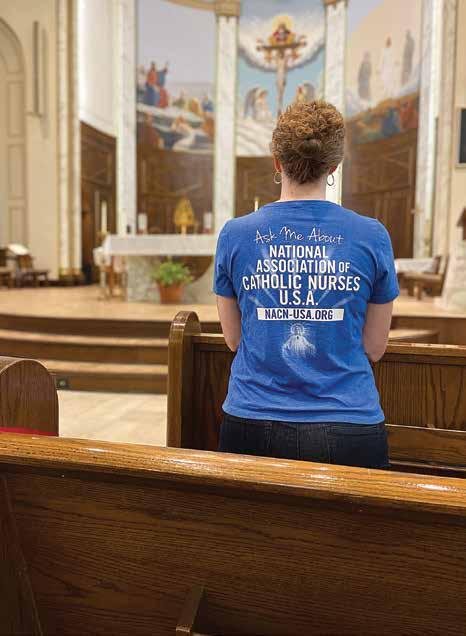
42 minute read
A BEAUTIFUL WITNESS
CATHOLIC MINISTRIES APPEAL A Beautiful Witness

Advertisement
BY M.D. PITMAN
The generosity of thousands of Catholics within the Archdiocese of Cincinnati to the Catholic Ministries Appeal (CMA) did not falter amid the difficulties brought on by the coronavirus. And Matt Reinkemeyer, director of development operations with the archdiocesan stewardship department, doesn’t see that generosity wavering as the 2021 campaign kicks off.
More than 25,000 families within the 200+ parish, 19-county archdiocese pledged $5.28 million to the 2020 campaign, with $5.21 million collected as of mid-December. That’s 1,000 more families who contributed this year over last year’s campaign.
“We continue to be amazed and humbled by the generosity of so many people,” Reinkemeyer said. “We had more than $1 million come in after the pandemic hit, and we actually ended up going over our goal this past year.”
He believes people’s compassion for the community and dedication to the Church will transcend the hardships of the pandemic. “History has shown that our families continue to be generous in whatever way they can,” said Reinkemeyer. And while it’s difficult to predict how the community will respond in 2021, “we remain hopeful,” he said.
The CMA assists thousands of families across Western and Southwestern Ohio from the contributions received during this annual fundraising campaign. “I’m grateful that so many people supported the CMA despite the struggles of this past year,” he said. “I’m also grateful on behalf of the ministries supported by the CMA. They are all dealing with the realities of COVID as wel,l and have been seeing an increased need for their services.”
The CMA supports six ministries within the archdiocese: the Center for the New Evangelization, St. Rita School for the Deaf, retired archdiocesan priests and senior clergy, campus, hospital and prison ministries, Catholic Charities Southwestern Ohio, Catholic Social Services of the Miami Valley, and Mount St. Mary’s Seminary & School of Theology and religious vocations. These ministries embody the beautiful witness of the Catholic Church in the community.
The Center for the New Evangelization receives seven percent of the CMA funds to help serve parish leaders involved in evangelization. The Center also serves college campus ministry, young adults, those preparing for marriage and the Hispanic community – among many others.
“The funding received is invested back into the parish community,” said CNE director Sean Ater. “We work to form, support and train parish leaders for local evangelization efforts. Our work directly helps parishes share the Gospel and form disciples across the archdiocese.”
Ater continued, “We provide direct ministry to young adults in college, in the discerning years before marriage and in preparing them for marriage and family life. We also serve the growing Hispanic community both by working with parishes with a large Hispanic population and by direct ministry.”
The CMA also supports Catholic Charities Southwestern Ohio (CCSWO), which serves more than 43,000 of the most vulnerable in 11 Ohio counties. The funding is “a vital way for parishioners to live out our communion as a community of disciples in the local Church,” said Dan Sarell, CCSWO’s director of mission advancement.
But beyond the monetary support the appeal provides – which sustains CCSWO’s works of mercy, like food pantries – Sarell said “the CMA builds the life of solidarity among parishes.”
“The annual campaign makes our universal call to holiness and to service real in the form of effective, real solutions that address the complex conditions of poverty, mental health, migration and parenting,” Sarell said.

Healing Begins When We ‘THINK ABOUT SOMEBODY ELSE’
BY MARK DANIS

Dayton-based singersongwriter Kevin Heider.
Progress in the spiritual life is experienced and expressed through an ever-increasing capacity to live for others, which requires developing a life of service and using the gifts God gives us.
“Like good stewards of the manifold grace of God, serve one another with whatever gift each of you has received.” (1 Peter 4:10)
Singer-songwriter Kevin Heider seeks to serve others through his gift of music. His latest album, Make an Honest Stand, reflects what weighs on his heart. Heider is concerned by our collective reaction to the pandemic and how it has led to increased division. “A new wave of anger, a sideways sort of justice,” Heider sings in “Think About Somebody Else.” It reveals Heider’s opinion that the virus and our uncivil descent into partisan politics is tearing at the very fabric of our society. He laments an abundance of “shoot from the hip, and fire at will,” communication, which he said leads to the dissolution of discourse.
Heider’s reaction to these destructive forces is to draw from his interior and artistic well, the place where the light of grace invades and offers hope. From here, he gives musical expression to the truth he believes dwells within him and within all of us – if we take the time to listen.

Though Heider does not characterize himself as a Christian musician, he acknowledges his view of the world is informed by his Catholic experience. He is a graduate of St. Charles Pre-K through eighth grade and Alter High School. He then went to Franciscan University in Steubenville, where he received his degree in Theology.
Heider’s musical roots are grounded in the poet-songwriters like Bob Dylan and Bruce Springsteen, along with narrative storytellers like Gordon Lightfoot, Dan Fogelberg and Simon and Garfunkel.
Today his songwriting, music and performing are guided by the words of St. Pope John Paul II’s Letter to Artists, which emphasizes the importance of the artist’s vocation and its vital contribution to society. Those who perceive in themselves this kind of divine spark which is the artistic vocation – as poet, writer, sculptor, architect, musician, actor and so on – feel at the same time the obligation not to waste this talent, but to develop it in order to put it at the service of their neighbor and of humanity as a whole.
Heider says his new album, Make an Honest Stand, serves to extend an invitation. “I would describe it as the difference between giving a lecture and inviting someone to a conversation.” Heider encourages us to move to a place where dialogue is possible. He finds strong affirmation for this in the words of Pope Francis, specifically in his most recent encyclical, “Fratelli Tutti.” Heider said he received a copy of the document on Oct. 3, the day it was published, and he read it over that weekend. “It felt like the Pope was writing my experience of the past many months.”
Pope Francis writes about our need for solidarity among people, which he defines as “thinking and acting in terms of community.” The Pope explains, “the existence of each and every individual is deeply tied to that of others: life is not simply time that passes; life is a time for interactions.” These human interactions are now being interrupted by discord and civil division.
The remedy is for communities to begin to practice what Pope Francis calls “penitential memory,” defined as our ability to accept our past, with all its pain, conflict and regrets, while not allowing it to cloud our future. Heider champions this idea and his music intentionally speaks to the need for what he calls, “an examination of our collective conscience.”
In his song, “Don’t Let the Flag Touch the Ground,” Heider gives artistic expression to this call for solidarity. He appreciates Bishop Robert Barron’s encouragement to artists to lead with beauty, but Heider also wants his music to resonate with listeners and serve “as the seed for contemplation and a genuine invitation to dialogue.”


A CLOSER LOOK
NO ATHEISTS IN ART GALLERIES
When I taught theology to undergraduates, I would ask for a show of hands of those students who agreed with the statement, “beauty is in the eye of the beholder.” In most cases every hand went up, even from the most devout students. And my reply would be, “I didn’t realize I had a room full of atheists.” I would then ask how many agree with the statement, “there is no such thing as beauty.” Inevitably, not a single hand would go up, to which I would respond, “Well, it looks like I have a classroom full of either confused atheists or misguided Christians.”
This led to a lively discussion on the order of creation, the nature of art, the kinds of claims artists make and the role of beauty in moral and religious life. My goal was to illustrate that, “beauty is in the eye of the beholder” is equivalent to the sentence, “there is no such thing as beauty,” and that the latter sentence is not compatible with belief in the God who Christians worship, or even with belief in objective good. In other words, “there is no such thing as beauty” is equivalent to “there is no such thing as truth.” None of my students would agree that there is no such thing as truth, even if they were confused about what truth is and the various ways it can be claimed – including through artistic expression.
What most of them really thought is that artistic tastes legitimately vary from person to person, which is true. But this is quite different from believing that beauty is merely the subjective opinion of the person observing the photograph, listening to the opera or reading the novel. If beauty is solely in the eye of the beholder, then judgments of artistic evaluation are nothing more than arbitrary assertions, divorced from any correspondence to truth and goodness outside the emotive preference of the observer. Often it took a lot of work to lead my students to this conclusion. For, like many of us, while most of them were confessed Christians, they were unclear about how their faith impacts the way we ought to think about beauty and art.
MORAL AND AESTHETIC TRUTHS One cannot be a moral absolutist and an aesthetic relativist, because moral and aesthetic truths are based in the same order of creation that is fundamental to Christian faith. Expressions of beauty and morality are both participations in the mind of God and cannot be separated from one another. If one rejects the reality of beauty, one necessarily rejects the reality of morality.
A corollary of this is that beauty, like moral truth, leads us toward God, who is its source. Just as we cannot affirm belief in God and deny objective beauty, neither can we affirm the reality of beauty and (consistently) deny the existence of God. Beauty, like morality, implies order and purpose in the world; and that order and purpose can only have one source: God.
This understanding of the correlation of beauty, morality, truth and order is at the heart of the conversion of one of the greatest theologians in the Christian tradition, St. Augustine. In his Confessions, St. Augustine explained how
he came to understand that quest for beauty is the quest Now, one might object that many artists are professed for God, and that the latter cannot be separated from the atheists. Some even create art for the purpose of expressing former. All creation is from you, God, he their belief that there is no meaning to prayed, “O One and Only, from whom life; no order to the universe; no truth. is all measure, O Most Beautiful, who But think about it. Even that artist wants give beautiful form to all things and set you to believe that his vision of beauty (as all things in order by your law.” To seek beauty is to seek God; to acknowledge Beauty, like morality, well as morality) is the true vision. She wants her art to convince you that the beauty is to praise the God from whom implies order and assertion “there is no truth to which art it comes. purpose in the corresponds” is a true assertion. In other REVEALING THE BEAUTY AND world; and that words, all artistic assertions are assertions of truth claims. Like moral truth claims, MIND OF GOD order and purpose they might be – and often are – false. Of course, people can have rigorous, good-faith conversations – even arguments – about what painting, play can only have one source: God. Ugliness is the privation of beauty, just as evil is the privation of good. But the or poem constitutes authentic beauty. search for beauty, like the moral quest, is But such a conversation must be in the context of an the search for the God in whom beauty and morality are agreement that judgments of beauty are claims about the perfectly obtained. You might find a lot of confused people correspondence of the artistic expression with some order in art galleries, but you will find no atheists there. of beauty outside the work of art itself and the person who DR. KENNETH CRAYCRAFT observes it. Beauty is not an abstract concept, but rather is an attorney and the James J. Gardner Family the name we give to human creative endeavors that, we believe, conform to standards of order and purpose – that Chair of Moral Theology at Mount St. Mary’s Seminary & School of Theology. He holds a Ph.D. in moral theology from Boston College, reveal the beauty of the mind of God. and a J.D. from Duke University School of Law.
Explore all that our senior living community has to offer from the comfort of your own home! Participate in an online virtual tour today to see our dining room, courtyard, suites, and everything in between.

T AK E Y OU R T OU R T O D A Y B Y VI S ITIN G OU R WEBSIT E
A T WW W . T R IPLEC R EEK R ETI R EMEN T. C O M ! |
A SS IST E D LI V IN G | IN DE P E N DE N T LI V IN G
MORGAN STANLEY
Wealth Management • Retirement Planning • College Savings Plans
BRIAN ANDZIK
First Vice President Financial Advisor 4380 Buckeye Lane, Suite 200 Beavercreek, OH 45440 937-431-7880
brian.m.andzik@morganstanley.com NMLS#1868565
2019 Morgan Stanley Smith Barney LLC. Member SIPC.


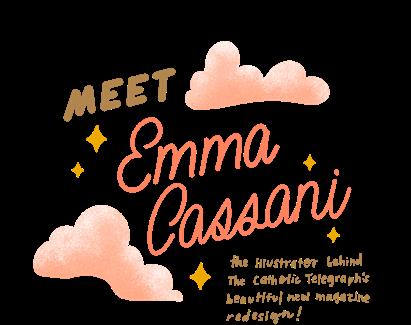
Emma – tell us a little bit about yourself!

I grew up on the east side of Cincinnati with my lovely mom, Marjie, deacon dad, Mike, and older sister, Maria. I went to IHM, St. Ursula and Marian University in Indianapolis for college. I majored in graphic design with minors in art history and pastoral leadership. I first entered Marian University pursuing a religious education degree and quickly determined that wasn’t for me. I felt there was a piece of me I hadn’t been paying attention to: the artist.
I talked to a lot of people and prayed about it. To be honest, I didn’t really know much about graphic design, but I went for it, and I’m so glad I did.
I was also part of San Damiano, a faith community designed to prepare and form students into Church leaders in their desired major. I learned I could combine my two loves: creativity and faith.
I recently moved to Hyde Park with my good friend and roommate, Haley. We have collected and grown more than 40 house plants. It’s especially important for me to be surrounded by life and beauty, as plants and the natural world have a large impact on my art. When I’m not working, you can find me hammocking, working on my bullet journal, thrifting, walking to local coffee shops, hanging with my friends or family (I’m an aunt to four!) or pampering my sister’s dog.
When did art become your passion?
Ever since I could hold a crayon, art has been a strong passion of mine. I always looked up to both my grandmothers who were artists – my dad’s mom, Nana, a watercolor painter, and my mom’s mom, Grandma, a pen-and-ink artist, art teacher and crafter.
Art can manifest itself in many ways, what drew you to illustration work?
I went to school for graphic design, but even through my classes, I found I appreciated the creative freedom and playfulness that illustration allowed in design. I felt graphic design often lacked the human quality fine art has. Illustration was a way for me to connect fine art and graphic design. In my design work, I do many things by hand instead of jumping straight to the computer. I like the organic, hand-crafted quality and texture drawing-by-hand allows.
Why do you think it’s important to connect your art style with your faith?
My art style is constantly growing and changing. But what stays the same is its whimsical, playful and often childlike quality. There is also a sense of the simple, everyday life in my work, which I think is important to incorporate into Church art.
When you think of faith-related art, the beautiful Renaissance classics come to mind – and that’s great. But, these amazing and perfect artworks can lack a sense of relatability to us today. The Renaissance artists rendered God and the saints as heavenly and perfect beings. This is true in some sense, but God was also human. The saints experienced life and its many sufferings. The goal of my faith-related artwork is to show the “humanness” of the holy figures.
What / who inspires you?
Whenever I’m starting a new project, I have to sit down and be in a space that is inspiring. I like to be surrounded by nature. So, that may be a walk down the bike trail, sketching in the park, sitting in my office window, or enjoying a hot drink in my comfy chair surrounded by my many house plants. I’ve always seen God through nature, which might be a part of why I find it so comforting and inspiring.
I am inspired by the “little things” in life, the things that might be overlooked, mundane or under appreciated: the experience of enjoying a hot coffee or tea, a well-sunlit corner playing with shadows, a new bud on a plant, the symmetric patterns of moths.
My favorite artists/designers/illustrators of today are Cheyenne Barton, Rebecca Green, Kay Hunt (Ohkayyay), Steffi Lynn (Have A Nice Day), Jenna O’Brien (shoptwentyseven) and Chandler Subra. I am so inspired by these women, their techniques, subject matters and fun, childlike outlook on life.
I am also heavily inspired by the impressionist period. My favorite artists are Van Gogh and Matisse. I love Van Gogh for his “painterly” style (the ability to see brush strokes and texture), dreamy point-of-view, and how he experiments with light and color. I love how Mattise exquisitely uses bold color, line and perspective to convey emotion and whimsy.
What other Catholic artists would you recommend readers take a look at?
Check out Erica Tighe-Campbell (Be A Heart), Tisa Muico and Tricia Dugat (Providential Co). I am inspired by these incredibly creative Catholic women artists.
What’s your advice for budding artists?
In the words of Matisse, “Creativity takes courage.” Don’t be afraid to push yourself, challenge yourself. If you want to show your inner thoughts and feelings, don’t be afraid to be vulnerable. If you want to say something with your art, don’t worry what other people will think, just say it. If you want to sell your work, do it. Stop holding yourself back. You were made for great things. Take risks, make connections, be patient with yourself and do not compare your work to others. Practice, practice, practice and pray.

Evangelizing Through Art & Beauty
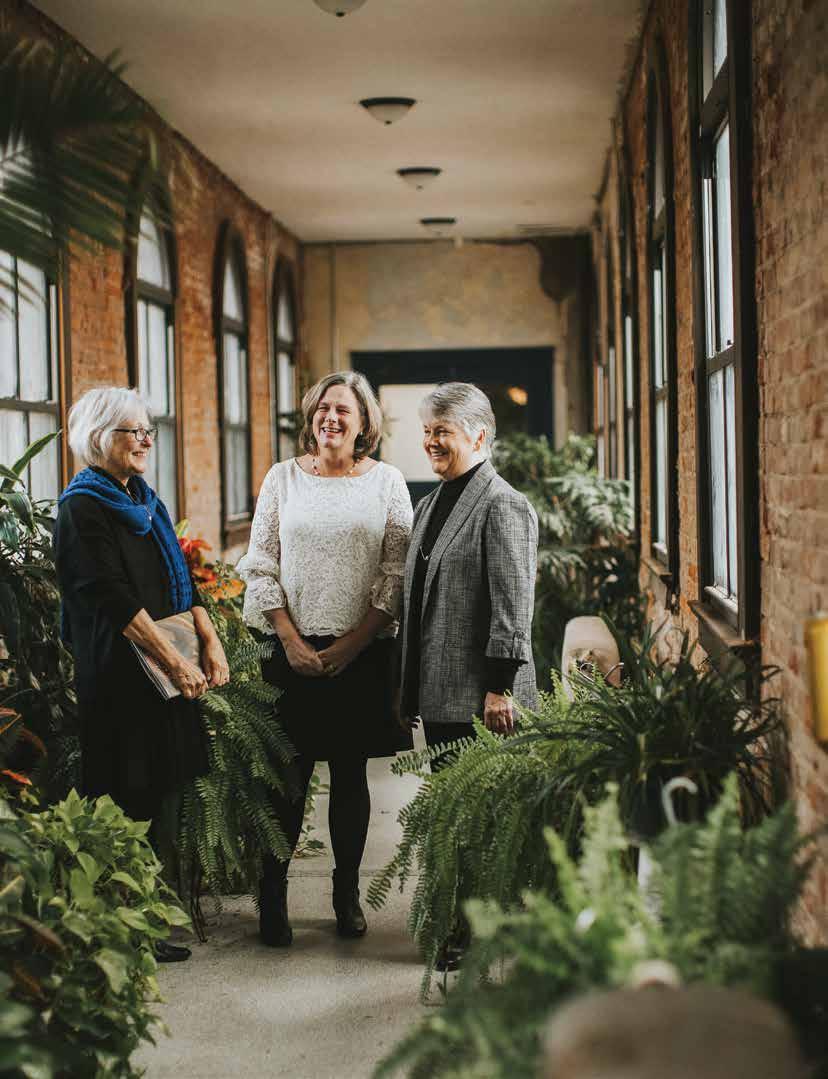
Angelico project co-executives and founders: Nancy Carolyn Smith, Loraine Muldoon and Maureen Teller.
Imagine a place where God comes alive; where your physical senses are exposed to the power of the Holy Spirit – through sight, sound, touch and even taste. Now imagine experiencing such beauty along with other members of a Catholic community – and now you have The Angelico Project.
“Very simply, The Angelico Project is a lay Catholic initiative to evangelize souls through truth, goodness and beauty by promoting the arts, thought and cultural events,” said Nancy Carolyn Smith, a sculptor and one of three co-executives of the new organization.
According to Maureen Teller, a former professional dancer and co-executive, the vision for a Catholic arts organization came about in 2017 when she heard an interview on Sacred Heart Radio about the Sheen Center for Thought and Culture in New York City. Named for Archbishop Fulton J. Sheen, the Sheen Center is a Catholic-affiliated performing arts complex and art gallery sponsored by the Archdiocese of New York.
“That was a galvanizing moment for me because the Sheen Center was founded to evangelize through goodness, truth and beauty through artistic performances,” explained Teller. “I was like, ‘If they can have this is New York, why can’t our archdiocese have it here, too?’ ”

Teller’s first phone call was to Smith, a fellow homeschooling mom of four and grandmother of nine. Exuberant with ideas and possibilities, Teller said her next conversation was with Jay Muldoon, a Catholic playwright, director and educator whose wife, Loraine, was friends with the ladies.
“I saw Jay Muldoon at a sports practice, and a big light bulb went off in my head, and I was like, ‘Jay – theatre! Oh my goodness!’ And so I ran over to his car window, I can still feel like the wind in my hair, I can feel myself looking in his car window, talking to him with little Logan in the car seat behind him. I have goosebumps right now because I still feel so excited,” laughed Teller.
Loraine Muldoon, also a co-director and homeschooling mother of six boys, brings a background in business and strategic planning to The Angelico Project. But it was her exposure to seeing the effect her husband’s Catholic plays had on others that moved her to get involved in something bigger.
“We had seen the real impact of inviting someone to a show and presented with this truth that’s weaved in and we had seen school students have conversions, people in the audience have conversions, cast members, backstage kids have conversions,” explained Muldoon. “And so we had this piece of evidence and we have this definite idea coming out of the Sheen Center that was like, ‘Yeah, that makes sense and we want to bring some of that to Cincinnati.’ ”
Brainstorming sessions at dining room tables and coffee shops over the following weeks and months led to a core group of founders: Sharon Conrad, Paul Dell’Aira, Jay and Loraine Muldoon, Nancy-Carolyn Smith, Dan and Maureen Teller and Sophie Vietas. Inspiration for the name came from Italian painter Blessed Fra Angelico, patron saint of Catholic artists. The group then presented their idea and business plan to the Archdiocese of Cincinnati and received seed money from the New Evangelization allocation of the Catholic Ministries Appeal.
Sister Therese Marie, Franciscan Daughters of Mary, enjoys the inspirational paintings on display at The Angelico Project’s “Midwinter Light” Juried Art Exhibition on Feb. 1, 2020. The exhibit ran at the Women’s Art and Cultural Center in Mariemont. It featured submissions from local artists.
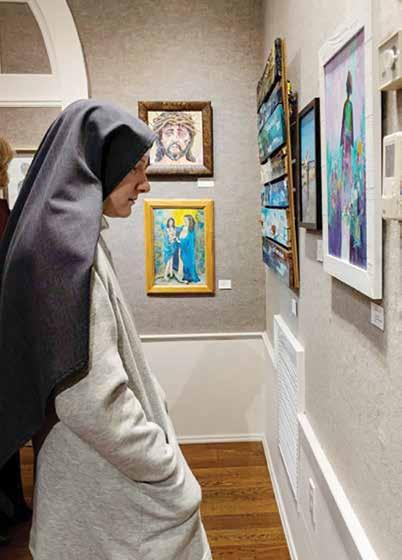
“We saw The Angelico Project as a prime example of the new evangelization, using the arts to reach people with the truth and beauty of the Gospel,” said Sean Ater, director of the archdiocese’s Center for New Evangelization.
The Angelico Project became incorporated as a nonprofit in Nov. 2018, and the founders wasted no time establishing a board of trustees and a board of clergy advisors. The first Mass for Catholic artists was held Sept. 12, 2019, drawing an unexpectedly large crowd to the Cathedral Basilica of St. Peter in Chains in Cincinnati.
“It was beautiful,” recalled Smith, who is a member of the Catholic Art Guild in Chicago. “Making art, for artists, is a lot of times a very solitary endeavor and so getting together to pray together... all these different arts unified in the faith, it was a really beautiful event.”
It’s apparent the vision, belief and love for The Angelico Project is strong for Smith, Teller and Muldoon. They feel they are called to do the will of God by “evangelizing souls and transforming the culture by promoting the good, the true and the beautiful through the arts, thought and culture,” as stated in the organization’s mission statement.
Three pillars form the backbone of The Angelico Project in its mission: a Catholic arts guild; artistic performances and presentations; and education of the person. Sponsored events have included film screenings and movie nights, art exhibitions, speaker series, podcast series, radio dramas, painting events and even a prayer hike.
“We did a hike at Winton Woods led by naturalists and at key places, we paused and prayed a psalm as a group … in the midst of this hike, in the fall beautiful colors,” said Teller. “Then we came back to the shelter and had a coffee and hot beverage truck and a food vendor who had sweet baked treats and we had a musician who played folk music and people just loved it.”
For these women, thinking outside of the box not only gets them excited, but motivated to do even more, including working closely with schools and creating events of interest.
“We want to have a film festival,” said Muldoon.
“We’re going to have a scriptwriter workshop in February, virtual,” said Smith, excitedly. “
“We plan to make a call-out to writers to submit radio dramas,” Muldoon added.
The group will also host an art competition in different categories for the design of holy cards to be distributed during the 200th anniversary of the archdiocese in June. Money to support these endeavors comes from membership in the art guild, donations and the Catholic Ministries Appeal.
Smith said the guild plans to host workshops to “raise the quality of the artwork” and to publish a directory of Catholic artists “so that our pastors will know who’s the professional artist in their parish.” A tool that could come in handy for commissioned Catholic artwork.
“This is the very beginning of The Angelico Project and the guild, and we’re just beginning to know who we are,” said Smith. “When you bring the good, the true and the beautiful to an audience you want them to leave changed in their minds and in their hearts.”
For more information and how to get involved, visit The Angelico Project website at www.angelicoproject.org.
145 feet to the tip of the spire
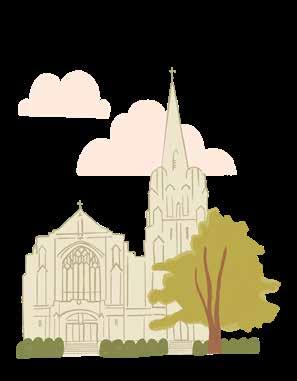
1 vaulted, hand-stenciled wood ceiling
42 all-volunteer choir members
4 CDs of choir music available
10 clerestory windows originally plain glass. Patterned glass made in America added in the 1960s.
2 major stained-glass windows made in Germany
More than 12 smaller windows share the same modernized Gothic style. The apse window features Christ the King and the narthex window features the apostles.
The Cincinnati chapter of the American Institute of Architects gave St. Cecilia Church in Oakley its top prize for new buildings in 1930. Designed by Cincinnati architect Edward J. Schulte, St. Cecilia combines Gothic and Art Deco design elements in distinctive ways. However, due to the Depression and WWII, the altar, clerestory windows and many other interior elements, were not completed for decades. “In the 60s, people did all kinds of terrible things to churches. When Father Jamie Weber came, we had a capital campaign and raised money to start from the outside in, fixing things in disrepair and putting things back to the way they were originally. Just last year we restored the original marble floor.” – Bob Kellison, Director of Music Ministry and Stewardship

“We are a traditional building and we sing good, theologically-solid hymns, chant, polyphony and modern liturgical music. We have turned the music program around to be more authentic to the intentions of Vatican II and the rubrics – and people love it. People sing here!” – Bob Kellison


St. Cecilia, a 3rd Century Roman martyr, is one of only seven women saints mentioned in the canon at Mass. According to legend, she converted so many people that the emperor tried to have her killed twice – the second time by beheading – but she still lived and preached for three days. She sang as she died, and thus she is known as the patron saint of music.
1908
First Mass held in Oakley Town Hall
1912
Original school built; basement used for church
July 13, 1913
First Mass in basement church
Sept. 8, 1913
St. Cecilia school opened, staffed by Sisters of Mercy
Nov. 29, 1928
Current church dedicated
1980
Exposed grate added to original 1928 Wurlitzer organ’s hidden pipes on the back wall, expanding its range and sound

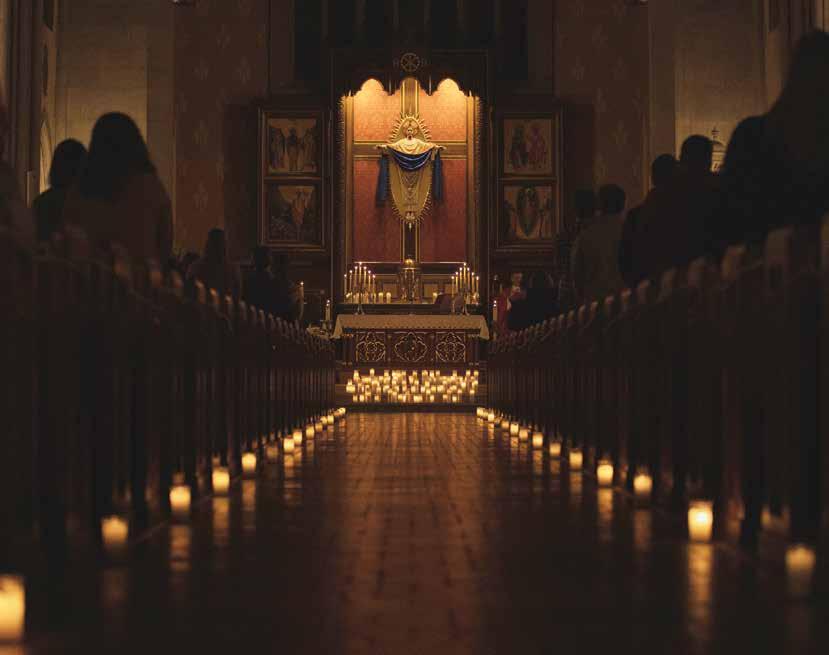
BY REGAN MEYER
The whole of St. Cecilia Church in Oakley is dark, save for hundreds of candles that light the altar. It’s the second Thursday in December, and Queen City Catholic’s Candlelight Mass is being celebrated by Archbishop Dennis M. Schnurr.
Before and during Mass both sides of the church house confession lines 20 people deep. More than 100 young adults kneel in humble prayer, while a traditional choir sings Advent hymns. The atmosphere is reverent, holy and beautiful.
When St. Cecilia Church launched the Candlelight Mass just two-and-a-half years ago, the idea was to provide a reliable night of worship for young adults in the area.
“When we were talking about it, we wanted something consistent. Same day, same time, the same location every month. Millenials don’t often have any kind of consistency. Young adults need consistency, something to continually come back to,” said Sarah Rogers, archdiocesan associate coordinator for young adult ministry.
That consistency has paid off. When the Mass first began in 2018, it drew around 50 attendees. Now, the Mass consistently sees around 175 people in attendance.
“Probably the main thing that I have seen from Candlelight Mass is a deeper sense of community with people,” Rogers said. “It holds people accountable. You know that your Catholic friends are at the Catholic event. You like your friends, so you’re going to go, and a few times after you go you get into it. It stops being ‘I just want to be with my friends.’ It creates a more intentional, communal aspect.”
Rogers said the Mass embodies Queen City Catholic’s mission to proclaim the true, the good and the beautiful.
“The way that we do that is backwards. Start with the beautiful, move to the good, and then bring people to the truth,” Rogers said. “Not everyone can agree with what is good. But they usually can agree with the beautiful. And we got from there to the truth.”
The Candlelight Mass is hosted at St. Cecilia’s because of the church’s beauty and strong young adult presence.
“The church is just so beautiful. It does a really good job with bringing the traditional and slightly more modern together,” Rogers said. “We wanted a place where everyone would feel comfortable gathering, whether they were [actively] practicing [their Catholic faith], or they fell away from it in college.”
The Mass also serves as a social outlet for young Catholics. Prior to the pandemic, attendees would gather at a local bar and socialize after Mass.
People would stay and visit until 12 a.m. Locals enjoying an evening out would witness young Catholics publicly discussing their faith. It became a means of evangelization.
The Candlelight Mass has brought some people to the faith. Rogers recalled a story of a young janitor at Mount St. Joseph University who was invited to Candlelight Mass.
“He said, ‘I walked in that building and I saw that beauty and I felt like I had been lied to my entire life about what Truth is,’” Rogers recounted.
Candlelight Mass at St. Cecilia’s, takes place every second Thursday of the month. Confessions begin at 6:30 p.m. and continue through Mass. Mass begins at 7 p.m.

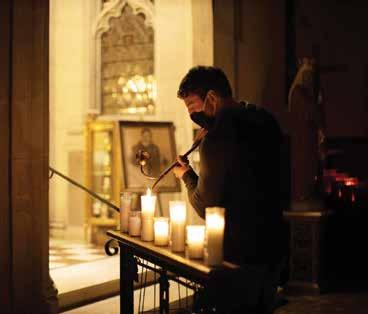
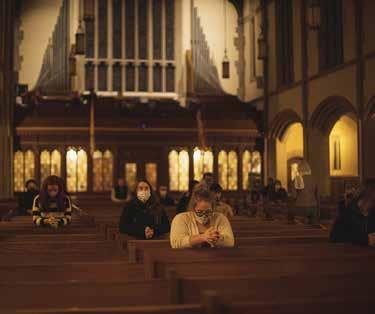

CATHOLIC AT HOME
FILL YOUR HOME WITH FAITHFUL ART
When we moved across town last February, one of the first things I did was hang our wall decor to make our new home feel like it belonged to us. The first thing to adorn our new walls was a crucifix. Modest in size, our crucifix packs a punch when it comes to meaning. With no words beyond the inscription “INRI,” it invites me to love, sacrifice and humility. It also points to the protection of Christ and that with Him, I can endure difficulty. There’s a depth of love the crucifix embodies that words fail to express.
Faithful art has a way of doing that. In imitating God as the Creator, an artist can draw out beauty, truth and goodness that, when placed in our homes, fortifies our faith. This is essential because the family is two things: the domestic church and the building block of society. With our spouses and children we need to strive for prayer, reverence, virtue and community. Living this way has a ripple effect for others we encounter, and gradually, the world.
What we see and hear at home has a deep impact on us. St. Therese said, “The world is thy ship and not thy home.” Holy images underscore her point – we’re made for total unity with God and He wants us with Him in heaven. Sacred art isn’t just a nice thing to have – we need it.
WHERE TO FIND CATHOLIC ART Finding Catholic or faith-based art is simple with a quick online search, but depending on your budget, the prices might be overwhelming. An unexpected place to look is your local thrift store. Sauntering Goodwill one day, I spotted a lovely statue of the Holy Family available for $1.99. I planned to donate it to my parish library or gift it to a friend – whatever I needed to do to rescue it. Once I brought it home, however, it became a favorite among our children so here it remains, still with the sticker on the bottom. eBay, Etsy or Facebook Marketplace. You’ll come across some unique finds by searching for your favorite saints or images of Jesus and Mary.
REFRESH YOUR EXPERIENCE OF SACRED IMAGES Sometimes we get used to a work of art and it doesn’t draw our attention after a time. To combat this, try shifting things around. Take your favorite wall hanging, statue or holy card and put in a different place so it grabs your attention again. If an item is situated more permanently, then walk right up to it and examine it more intentionally. Note your favorite details or notice new ones, and recall what they reflect about the Lord or our faith. It’s customary to kneel before holy art in church, and we should feel free to do so in our homes, as well. Decades after her passing, I learned that my grandmother often knelt in brief prayer before crucifixes and other pictures in her home. It’s funny, too, when my kids catch me mimicking my grandmother’s devotion. Initially they were thrown off by Mom praying in the hallway, but now they know to wait a second while I wrap up my short hello to heaven.
Faithful art at home is foundational to deeply experiencing Catholicism. Without words, we receive a steady invitation to holiness from the gaze of a patron saint or crucifix, and through it we’re drawn closer to the Lord.
One of my family’s favorite pieces of art is a simple, carved picture of Our Lady Star of the Sea. Though we’ve all seen it thousands of times over the years, a new truth struck my 7 year-old recently. “Look!” he said pointing to the small boat in the corner of the picture. “Mary’s watching the boat on the water. WE are on the boat! and she’s making sure we get to Heaven.”
KATIE SCIBA
is a national speaker and Catholic Press Awardwinning columnist. Katie and her husband, Andrew, have been married for 11 years and are blessed with six children.

Carroll High School Student Blends Faith & Art
BY BONNY VAN
Sam Wittmann is not your typical high school junior. He’s also an exceptional artist who has drawn the connection between his art and faith, thanks to a class assignment.
“The project was a study of drawing hands from life,” explained Renee Merland, chair of the visual arts department at Carroll High School in Dayton. “Students used their own hands as their reference and chose one object to hold in their hand that was symbolic or meaningful to their life.”
The result was an assortment of artwork featuring childhood toys or small stuffed animals – even favorite foods and beverages made the cut. Against the backdrop of typical teenage memories, Wittmann’s work, a color pencil drawing of his right hand holding a rosary, showed profound depth, both physically and spiritually.
“When I was assigned the project I was thinking of things that were significant to me,” said Wittmann. “I was scanning around my room and I caught a glimpse of my rosary... a gift for my First Communion. I decided to use it because I realized it had been a part of my faith journey from the moment I started receiving the Eucharist.”
Wittman recalled when he was younger and had trouble falling asleep or was going through a tough time, his parents told him “the best thing you can do is pray the Rosary.”
“I can tell you without fail it always works, so praying the Rosary has always been there,” said Wittmann.“It actually got me through some of the lowest times in my life, so it’s always been there, just a few feet from me.” Wittmann said he wanted the crucifix to be the “main focal point” of the piece, which expertly depicts light and shadow on both the rosary beads and hand.
“The drawing gives the viewer a glimpse into this intimate moment with God, as it focuses on the simple human hand wrapped in the complexity of the spiritual mystery and blessing of the rosary. The hand is symbolic in that we hold and touch what is precious to us, Merland said. Carroll High School principal Matt Sableski, who also happens to be Wittmann’s uncle, said teachers finding ways to connect their content to the students’ journey of faith is central to the school’s mission.
“The visual arts provide so many vehicles to make that happen,” Sableski said. “I am very proud of Mrs. Merland for providing these opportunities and of Sam for expressing himself in this way. He is truly gifted!”
Wittman is vice president of the National Art Society and coxswain and captain of the men’s varsity rowing team for the Dayton Boat Club. His future plans include using “the talents God gave me” to continue his studies in a creative field such as art, architecture or graphic design. For now, though, he is pleased to know his art is touching others in such a dramatic way.
“I guess I want everyone to enjoy it as much as I have – helping to make someone’s day better or slightly more manageable because I know we’re all going through a lot of stressors right now,” he said. “Hopefully the viewer shares some of my own pride and fascination with the craft of art.”
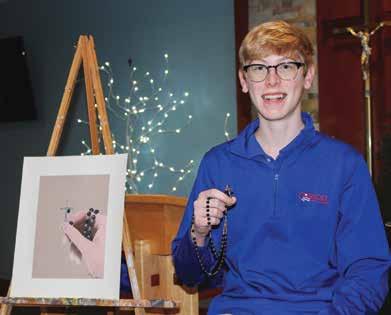
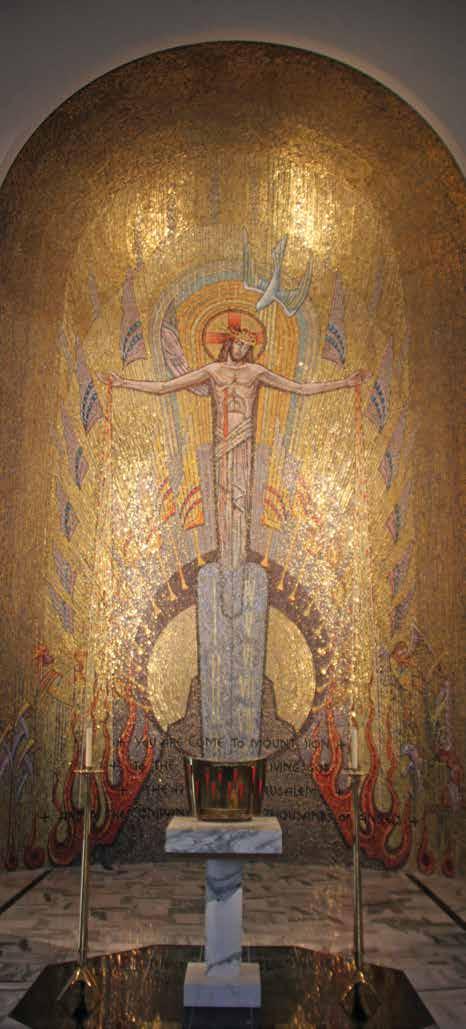
Many Tiles, One Message
Carthagena’s St. Charles Center Holds Historic Art Treasure
BY MATT HESS
Many passersby notice the blue-domed St. Charles Center on US 127, although few cave to their curiosity and enter it to see its beautiful chapel. Now a private residence for seniors and priests, this former seminary has a mosaic in its Assumption Chapel which continues to preach Precious Blood spirituality to those who visit it.
The Missionaries of the Precious Blood founded St. Charles Seminary in Carthagena in 1861, and with the seminary’s expansion the chapel was built in 1906. The vaulted ceilings and graceful arches still draw one’s thoughts up to heaven – as does the music, which fills that vastness from the chapel’s commanding Holtkamp organ with its 1,600 pipes.
In this expanse of space, the eye is drawn to the focal point on the back wall of the chapel. This mosaic, in glittering gold and red tones, is a unique feature of the chapel which cannot be found anywhere else in the Land of the CrossTipped Churches.
The mosaic was the joint effort of Father Aloys Dirksen, C.PP.S., and a German artist as a way of bringing to life Precious Blood themes in the Letter to the Hebrews. Installed as part of the renovation of the chapel to celebrate the centennial of the seminary in 1961, this mosaic was crafted in Germany in sheets so that it could be shipped to America. Its cost was under $20,000 at the time, but even then it was seen as a priceless piece of art to those who prayed before it. Workers applied fresh adhesive to the apse wall and applied the shimmering tiles sheet by sheet.
Father Paul Wohlwend, C.PP.S., a resident of St. Charles and tour guide for those visiting
the chapel said, “The mosaic symbolizes God’s love for us in sending His only begotten Son who shed His Blood for all mankind.” This theme can be seen in the many figures depicted in the mosaic.
In the center is Christ, supported by the powerful hand of the Father and in the presence of the Holy Spirit. His Precious Blood falls from His hands and side, representing the covenant sealed in the Blood of Jesus connecting heaven and earth; uniting all of us as God’s children. Around Christ are angel wings and trumpets, which symbolize angels praising God for gloriously reconciling Himself to humanity. The gold tiles, which sparkle throughout, are a vivid image of God’s glory and the beauty of the heavenly Jerusalem.
There are several images that remind the faithful of how God reached out to His people in the Old Testament. Mount Sinai is near the bottom of the mosaic surrounded by flames, which represent God’s presence in giving Moses the Ten Commandments. These commandments, represented by their numbers, are arranged in the mosaic with the three commandments that concern love of God on the left and the seven that concern love of others on the right. Father Wohlwend said, “This is a reminder that we must love God in return. ‘If you love me, keep my commandments.’”
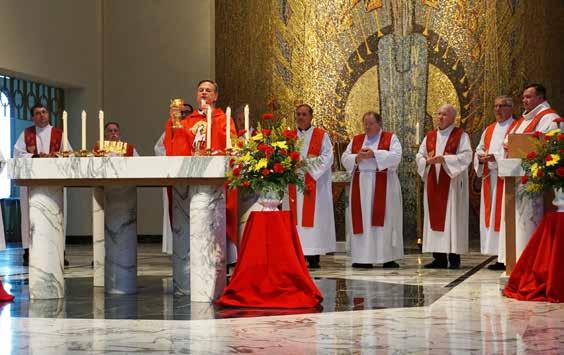
The final images in the mosaic prefigure the sacrifice and priesthood of Jesus from two episodes in the Book of Genesis. On the left, the priest Melchisedech offers bread and wine as a sacrifice to God. Opposite is a depiction of an angel stopping Abraham’s sacrifice of Issac by directing him toward a ram instead of his son. Both of these sacrifices are superseded by Christ, who offers His own Blood and is thus the centerpiece of the mosaic.
For the seminarians of the past and for us now, this beautiful piece of historic art is both a call to reflect on the beauty of our faith, and a lesson in the saving power of Christ’s Blood. It is a reminder that we are called to love just as selflessly as He did. Reconciled with the Lord, we hope to experience the words from the Letter to the Hebrews quoted in the mosaic:
“You are come to Mount Sion To the city of the living God The heavenly Jerusalem And to the company of many thousands of Angels.”
cpps-preciousblood.org
MISSIONARIES We’ve been in OF THE PRECIOUS T ar he ministry in the chdiocese since 1844. mission of our priests, BLOOD la religious y associat br es ot is he to rs and bring all people near through the Blood of Christ.

Dave Allen
The Music Man of Cincinnati is an Elder High School Legend
BY KARY ELLEN BERGER

For more than 50 years, the name Dave Allen has been synonymous with the music at St. William Church in Price Hill and the Singing Panthers Glee Club at Elder High School.
“For someone who has been actively involved with teaching high school-aged students for more than 50 years, Dave is a legend,” said Kurt Ruffing, Principal at Elder High School. “He continues to provide our students with a quality musical education in the classroom and on the stage.”
“As a student at Elder [from 1984 – 1988] I didn’t find what I was truly passionate about until I took glee club and a lot of that has to do with Dave Allen,” said Tom Reiring, the Director of Development at Elder High School.
Allen came to Cincinnati from Youngstown by way of the University of Cincinnati Conservatory of Music, where he graduated in 1957 with a performing arts degree. A few years later, he began teaching and leading the music ministry at St. William.
“I’ve been there for a few years now,” chuckled Allen.
The same can be said for his time at Elder, where Allen started in 1969.
“I got a phone call that the choral director was sick and was asked if I would like to fill in,” said Allen. “I guess they’re still looking for a permanent replacement!”
For 52 years, Allen has been directing the glee club at the high school. The Singing Panthers perform several times a year and have already performed twice this school year. “Dave and the glee club are my go-to — always dependable to represent our school in the most positive way, not to mention the attendees love seeing them, talking with them and hearing them sing,” said Reiring. “It’s as simple as a call to Dave to ask if he could have the boys there to sing for a Mass, a dedication ceremony, an alumni picnic or some other special program involving our alumni and friends. Without hesitation, Dave and the boys are always there.”
The Singing Panthers not only perform as a group, but also sing with the choirs at Seton High School as part of the Seton-Elder Performing Arts Series.
While there is already a strong connection between Elder and Seton High Schools, there is also a special connection for Allen – his daughter, Kathy, is the president at Seton.
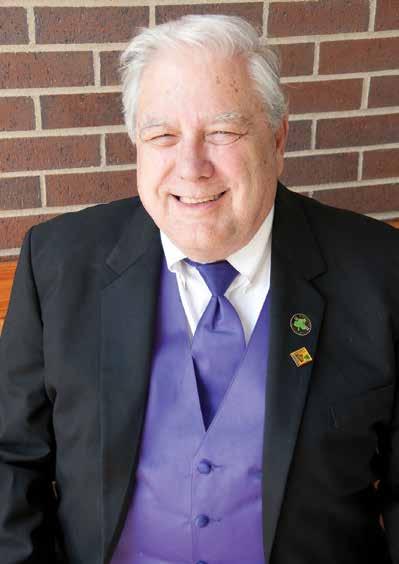
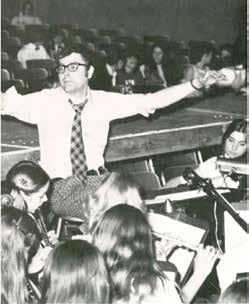
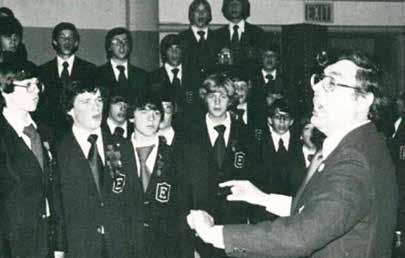
Allen and his wife, Carol, are the parents of three daughters – Kathy, Colleen and Mary Beth. They are also grandparents to eight children and young adults. In his free time, Allen enjoys traveling – including the European concert tours he has taken with the Singing Panthers choir. Every other year, Allen organizes the trip that has included visits to countries such as Italy, Ireland, Germany, Hungary, Slovenia, England, Wales, Scotland, Canada, Austria and France.
“Dave is a father figure (maybe now a grandfather figure!) to many students and graduates because of the relationships he has established with them,” said Ruffing. “He truly cares about them and their families.”
Other accomplishments of Allen include co-founding and leading the Cincinnati Metropolitan Orchestra (CMO) and being an established organist and pianist. Allen showcases the latter weekly at St. William where he acknowledges there has had to be some changes because of COVID-19.
“There are no hymnals out right now, so we are mostly singing acclamations and there are organ interludes,” shared Allen.
Change is something though, Allen noted, that drives him to continue living out his passions.
“With teaching, it’s a wonderful vocation that’s constantly evolving,” said Allen. “There are new challenges each year.”
Allen added, “Teaching is not about us, it’s about the kids. They’re the real stars of the show – and that’s the satisfaction.”
LIFE IN ART
This issue is about art and beauty, and there is a lot of both in the pro-life movement. There is the beauty of the image of an unborn child viewed on an ultrasound machine. While it is difficult to get reliable statistics on how many women in crisis pregnancies change their minds about abortion after viewing their child on an ultrasound machine, any pregnancy center will tell you it can be very helpful.
Want to help ensure your children are raised as pro-life Catholic kids? Catholic art in your home can help. The image of Our Lady of Guadalupe, given to St. Juan Diego in 1531, is full of imagery that can only be explained as miraculous.
Finally, the beauty and importance of chastity is integrally connected to the success of the pro-life movement.
Listen to this month’s podcasts on each of these topics at being-pro-life.buzzsprout.com.
• Feb 2: Lee Carter on ultrasound images
• Feb 9: Katie Sciba on how art in the home helps raise Catholic kids
• Feb 16: Father Ethan Moore on the miraculous image of Our Lady of Guadalupe
• Feb 23: Jason Everett on the beauty of chastity in the pro-life movement
BOB WURZELBACHER is the director of the Office for Respect Life Ministries. He and his wife, Cindy, live in Sharonville with their two young daughters.


